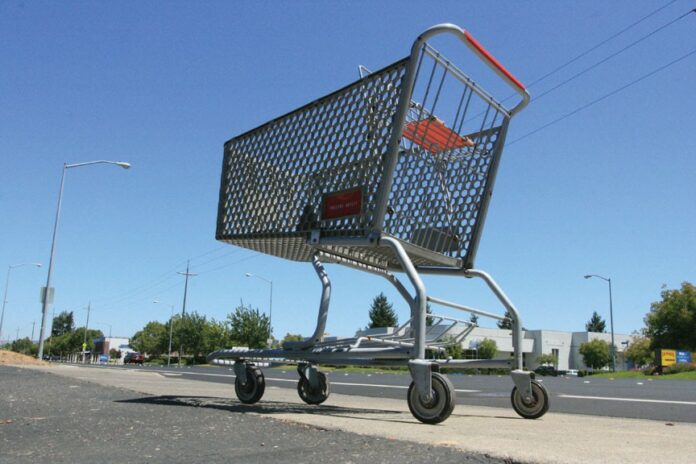Mark Moose walks quickly. He’s got to; since his truck was stolen a while back, his legs and rides from friends have been his only transportation, including to and from work as a tree trimmer. But Santa Rosa Avenue is long, and Moose lives far from the strip malls to the north.
For Moose, then, getting groceries means walking to Santa Rosa Liquor and Deli and seeing what’s in stock. “There’s not much variety, that’s for sure,” Moose says, hinting at understatement.
And Moose is by no means alone. The USDA calculates that inside the area roughly formed by Petaluma Hill Road, Highway 101, Highway 12 and Mountain View Avenue, 2,600 people have poor access to affordable, healthy food; 400 of those are low-income, according to the census. The USDA defines the area as a “food desert,” the poorest of three such designations in the North Bay, meaning many besides Moose rely on gas stations and liquor stores for provisions.
Brittany Thompson of Santa Rosa Liquor and Deli sees customers buying their daily necessities all the time, adding, “Pretty much everyone who shops here is a regular.”
In a rare respite from intercouncil bickering, the Santa Rosa City Council unanimously agreed to amend Santa Rosa’s general plan to ease grocery-store development last month, and the city planning commission meets July 26 to decide the fate of large grocery stores inside the food desert; the changes could mean an influx of chain stores to the area. Meanwhile, the Sonoma County Department of Health Services takes a grassroots approach to the problem, interviewing residents and working with grocers and schools to increase access to cheap, healthy food in the area.
“The choices that people make are usually shaped by the choices that they have,” says Anthony Taylor, health program manager with the Department of Health Services. And in southeastern Santa Rosa, choices are scarce. County research finds that unhealthy food sources—fast food restaurants and liquor stores—outnumber healthy food sources seven to one. In the rest of the county, the ratio is three to one.
[page]
The proposed changes include temporarily relieving community shopping centers of the requirement to develop residential buildings together with retail; conditionally allowing grocery stores to move onto Santa Rosa Avenue; and simplifying the terms the city uses to describe grocery stores. Additionally, at this week’s planning commission meeting, senior city planner Erin Morris will recommend allowing large grocery stores—20,000 square feet and more—to move into existing buildings within the area by permitted use. This would allow large grocery stores to skip the expensive process of a conditional use permit (CUP) and “just go for it,” says Morris, although the design review and environmental review processes would remain.
Keegan & Coppin real estate agent Tom Laguero is interested in developing the large building Circuit City once occupied on Santa Rosa Avenue, and has asked city council to drop the CUP requirement for grocery stores in southeast Santa Rosa. “Maybe we could help each other out,” Laguero writes in a letter to the council, mentioning that he has a grocery client interested in the site but that a CUP would kill the deal. Laguero’s client, Smart & Final, is a large 250-store chain.
Large chain stores concern councilmember Susan Gorin, who grilled Morris at the June 19 council meeting about the probability of retailers like Wal-Mart taking advantage of the loosened restrictions and moving in. But Morris says chain-store politics aren’t in a city planner’s jurisdiction. “We don’t zone by brand name,” she explains . “We zone by land use.”
Still, California grocers remain worried about the introduction of Wal-Mart Neighborhood Markets, a much smaller grocery version of the big-box store. As of February, 13 Wal-Mart Neighborhood Markets are planned in the state, set to open by early 2013, with four in the southeast Bay Area.
Beyond the immediate future, Santa Rosa’s 2030 general plan includes two proposed neighborhood shopping centers inside the food desert and one larger community shopping center on its border that, when developed, would put a grocery store a mile away at most from every resident of the area. When the USDA eventually declares southeast Santa Rosa a verdant grocery oasis, the CUP exemption will expire. And when the housing market improves, community shopping centers will have to tack on forgone residential units.
Until these policy changes begin affecting the food desert, shoppers at Santa Rosa Liquor and Deli only see three types of fruit, and there isn’t much produce at the nearby Shell station either. Santa Rosa Liquor and Deli, then, with nearly as many aisles stocked with alcohol as with grocery, with a smoke shop in the back half of the building, will have to suffice for the larger stores the city council hopes to attract.
For now, “this is their only option,” says Thompson.











